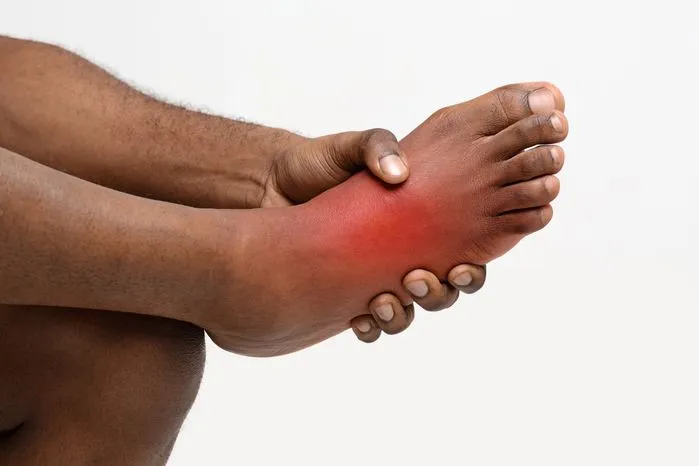
Heel pain is a common foot and ankle problem. It occurs under the heel or just behind the heel where the Achilles tendon connects with the heel bone. The foot and ankle are made up of 26 bones, 33 joints, and more than 100 tendons. If we overuse or injure the heel which is the largest bone in the foot, we may experience heel pain.
Causes of Heel Pain
In most cases, heel pain is rarely caused by injury. It usually starts as mild pain but has the potential to become severe.
Some of the common causes of heel pain include:
- Plantar fasciitis: This is the most common cause of heel pain. The pain is felt under the heel once too much pressure exerted on the feet damages the plantar fascia ligament. This ligament acts as a shock absorber, supports the arch of the foot, and aids in walking.
- Achilles Tendonitis: This is pain behind the heel. The Achilles tendon attaches the calf muscles to the heel. When this tendon becomes inflamed due to overuse or injuries it could lead to heel pain. Achilles tendinitis is common in athletes and sportsmen or women.
- Bursitis: The ankle bursa is a small fluid-filled sac that cushions and lubricates the ankle joint. It’s found at the back of your foot, between the heel bone and the Achilles tendon. Bursitis happens when the bursa becomes inflamed causing pain and swelling. Pain is felt deep inside the heel or at the back of the heel.
- Arthritis: The ankle joint is formed by three bones each with cartilage that helps prevent injuries by cushioning the spaces between the bones. Rheumatoid arthritis, an autoimmune disease causes heel pain and eventually results in bone erosion and joint deformity.
- Sever’s disease: This is a common cause of heel pain in active children between 8 and 14 who participate in activities that require frequent running and jumping. These activities can irritate the growth plate in the back of the heel.
- Haglund’s deformity: Severe inflammation and irritation can cause an enlarged bony bump to form in the back of the heel. This deformity is seen often in women who prefer high-heeled shoes such as pumps.
Other causes of heel pain include ill-fitting footwear, poor posture when running or walking, sprains and strains, osteomyelitis, and gout.
Symptoms Of Heel Pain
Heel pain typically starts mild and gradually becomes more severe. Some symptoms worsen just after getting out of bed in the morning or after a period of rest during the day, and then they improve with little activity. They may worsen again toward the end of the day.
Some of the common symptoms include;
- Stabbing pain in the bottom of the foot near the heel
- Ongoing or periodic pain especially after standing from a sitting or resting position.
- Redness and swelling
- Stiffness
- Tenderness
Risk Factors For Heel Pain
Certain factors may increase your likelihood of developing heel pain. These include:
- Being overweight or obese
- Wearing ill-fitting shoes without arch support and cushion
- Activities such as frequent running or jumping
- Spending a lot of time standing, especially on concrete floors
- Conditions such as arthritis and diabetes
Diagnosis and Treatment of Heel Pain
Your doctor will examine you from your knee to your foot asking you are a series of questions to establish your medical history. A physical exam is done to determine any nerve damage or any other condition. An x-ray may be required to check for bone fractures, ligament and joint damage, and arthritis.
The remedy for heel pain depends on the cause. Some heel pain can resolve within 24 hours with home treatment and over-the-counter pain medication. In the case of untreated Achilles tendonitis, surgery is done to repair the damage.
Non-Surgical Treatment of Heel Pain
Non-surgical treatment therapy focuses on easing pain and inflammation. Some of the treatment options available include:
- NSAIDs and corticosteroid injections to reduce pain and swelling. Long-term use of corticosteroids can have adverse effects.
- Medication: A heel pain reason like bursitis, arthritis, and gout will require medication to alleviate pain.
- Physical therapy to stretch the Achilles tendon and plantar fascia, and strengthen the lower leg muscles for better ankle and heel stabilization.
- Orthotic inserts: These are inserts that fit into the shoes. They help support, stabilize, and ensure proper alignment of the foot to reduce heel pain.
- Placing an ice pack over the affected area
- A night splint stretches the plantar fascia and Achilles tendon and holds them in a lengthened position overnight.
Surgical Treatment of Heel Pain
Surgery is unpopular when it comes to heel pain treatment. However, some pain causes such as a torn tendon or ligament may need surgical repair. One common surgery is done to detach the plantar fascia from the heel bone although there’s a risk that this may weaken the arch of the foot.
Heel Pain Prevention
It is not possible to entirely prevent heel pain. However, there are some easy steps to help you avoid injury. Practices like warming up properly before exercise and maintaining good health can help reduce heel pain injuries caused by running or jumping. In case a movement or activity becomes uncomfortable, it’s advisable to take a break. Maintain a healthy weight through exercise and eat the right diet.
Always wear the right footwear. Your shoes should provide adequate support, especially when participating in sports such as basketball, volleyball, and soccer. To reduce heel pain from walking, avoid sandals, and shoes that are too loose.
Bottom Line
Heel pain almost always improves over time with nonsurgical treatments. Don’t ignore pain. Call your health provider if the heel pain is severe or if it doesn’t subside after a week or two.

















